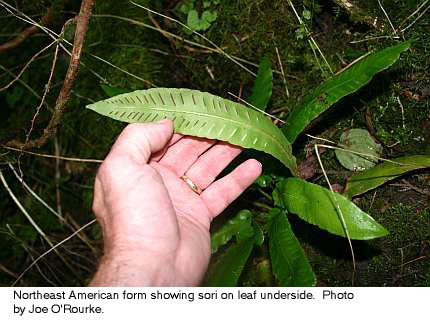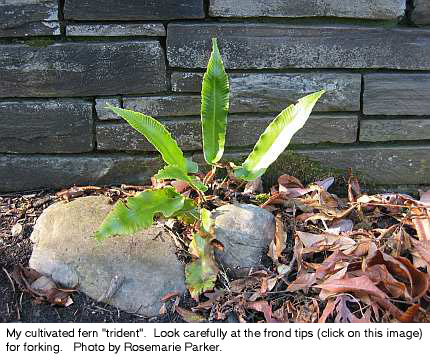A Real Rarity
Status & Range
The American hart’s tongue fern is state and federally listed as threatened, globally imperiled, and generally rare and very patchy throughout its range. It is currently known from two counties in NY, but ranges into New Brunswick, the Bruce Peninsula of Ontario, and Upper Michigan, with two disjunct populations in cool sinkholes and caves of Tennessee and Alabama. According to Don Leopold, the first discovery of this species in North America was at a central NY site in 1807, and the NY sites represent 9% of the US populations (Ref. 4). The European plants are much more wide-ranging both ecologically and geographically, and are relatively speaking, common, whereas the North American plants are very rare and local. As described below, this more exacting nature extends to its suitability to cultivation.
Appearance
 Hart’s tongue fern is quite distinctive when seen outside of a garden (where anything goes). The easy way to remember the look of this fern is given by Wikipedia. "The tongue-shaped leaves have given rise to the common name ‘Hart's tongue fern’. The sori pattern is reminiscent of a centipede's legs, and scolopendrium is Latin for ‘centipede’."
Hart’s tongue fern is quite distinctive when seen outside of a garden (where anything goes). The easy way to remember the look of this fern is given by Wikipedia. "The tongue-shaped leaves have given rise to the common name ‘Hart's tongue fern’. The sori pattern is reminiscent of a centipede's legs, and scolopendrium is Latin for ‘centipede’."
Long strap-like fronds are 6-8" long (up to 16" for European variety) and 1-2" wide (European variety is generally wider than the American variety). The frond is glossy, bright green, somewhat leathery, and the margin is entire. The frond tip can be pointed or blunt (more pointy in the American variety), the veins fork, and the base is chordate. The stalk (rachis) is brownish and glabrous, with lanceolate scales (again more pointy in the American variety). The sori are linear and perpendicular to the rachis; the American variety is likely to have sori only on the upper two-thirds or half of the blade, while the European variety MAY be more completely covered. Some individuals in the wild North American populations may have been modified by genetic contact with each other and/or European varieties, either accidentally or via misguided, albeit well-intentioned, efforts to "save" the plants by transplants and spore releases (Ref. 5). Thus some NY specimens may have some aspects of the European variety. (Ref. 6)
Habitat
The European variety is common in England, France and Germany, where it can be found on limestone walls of old churches & gardens and in calcareous ravines. It can also be found in scattered locations elsewhere in Europe. The American variety shows a similar preference for neutral to limy soil, rocks, and high humidity. American hart’s tongue fern is found on wet limestone cliffs, cave entrances, and outcrops (Ref. 1). In New York they are generally found on north-facing slopes (mid-slope position) under deciduous canopy or in glacial plunge basins and narrow meltwater channels with high humidity (Ref. 4).
Cultivation
 Although earlier texts state that both American and European varieties can be grown "if natural conditions are simulated" (Ref. 3), more recent texts strongly differ. To start with, several references note that part of the reason for the scarcity of the North American variety is due to plant collectors. William Cullina summarizes the experience of the New England Wildflower Society’s Garden in the Woods this way: Asplenium scolopendrium var. americanum has a "well-deserved reputation that is far less amiable [than the European variety]" ... [It has] proven recalcitrant in cultivation and quickly perishes even under expert care ... [As a] rare species, even spore collection is discouraged ... (Ref. 1)."
Although earlier texts state that both American and European varieties can be grown "if natural conditions are simulated" (Ref. 3), more recent texts strongly differ. To start with, several references note that part of the reason for the scarcity of the North American variety is due to plant collectors. William Cullina summarizes the experience of the New England Wildflower Society’s Garden in the Woods this way: Asplenium scolopendrium var. americanum has a "well-deserved reputation that is far less amiable [than the European variety]" ... [It has] proven recalcitrant in cultivation and quickly perishes even under expert care ... [As a] rare species, even spore collection is discouraged ... (Ref. 1)."
And why would you want to? A rare species which dies on the experts? The Garden in the Woods opted to grow the European variety as a substitute. The European variety grows very well in gardens and provides all the visual benefits of the native one. It can be started easily from spores and transplants well. This time, ethics, morality, and practicality all lead to the same conclusion. If you are so lucky as to see a wild hart’s tongue fern in the North American woods, leave every bit of it there. Take pictures. Wish it well. Don’t reveal the location!
References
1. Cullina, William, New England Wildflower Society, Native Ferns, Moss & Grasses, Frances Tenenbaum, 2008, p36-37.
2. EFloras: Flora of North America Vol. 2
3. Foster, F. Gordon, Ferns to Know & Grow, 2nd revised ed., Hawthorne Books, 1976, p152-153.
4. Leopold, Donald J., Native Plants of the Northeast, Timber Press, 2005, p40.
5. Nature Serve - Version 7.1 (2 February 2009), Data last updated: July 17, 2009 Nature Serve
6. Weldy, Troy and David Werier. 2009 New York Flora Atlas. [S. M. Landry and K. N. Campbell (original application development), Florida Center for Community Design and Research. University of South Florida]. New York Flora Association, Albany, New York. 2009 New York Flora Atlas
7. Wikipedia: Wikipedia
About
By Rosemarie Parker
Photos by Joe O'Rourke, Rosemarie Parker



